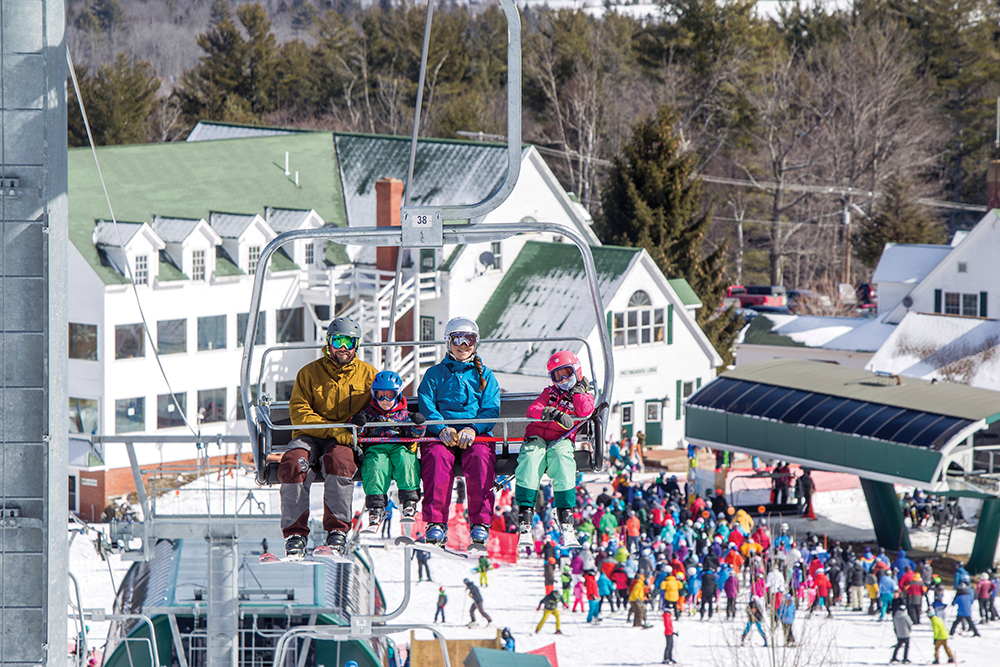
Skiers and snowboarders at the base of Ragged Mountain. Courtesy photo.
The weather outside may indeed be frightful and the fire delightful, but few have plans to remain cooped up this winter. With many weary of indoor activities as the pandemic rages, folks are continuing to invest in the great outdoors.
Summer saw record RV and bicycle sales, and now there are record sales of winter gear, skis and snowmobiles. According to Edward Klim, president of the International Snowmobile Manufacturers Association, sales are up across North America.
“It surprised everybody. We’ve been going strong for about three months and our peak season is just starting. Sales in New Hampshire are up at least 20% on new stock,” he says. “And it’s not just sleds, it’s clothing, helmets, parts and trailers.”
Rob Nadler, president of Ragged Mountain Equipment, a manufacturer and retailer of high-tech winter clothing in Intervale, says they sold 10-years’ worth of float tubes this summer.
“It’s unbelievable,” says Nadler. “We had a really good summer because there were a lot of big city refugees coming up to the Mount Washington Valley to get away. It’s the busiest summer we’ve ever seen.”
With increased interest in back-country sports, like snowshoeing, Ragged Mountain Equipment’s long underwear, windproof and water proof tech products are expected to be in demand.
George Philbrick, owner of Philbrick’s Ski Board and Bike in Dover, says demand for bicycles was “out of control” and expects it will continue into next spring. He says he was receiving bikes in November that he ordered in May.
“Fat tire bikes are a unique phenomenon,” says Philbrick. “They can be used on snowmobile and cross country trails and give cyclists something to do in the winter. Growth has been crazy. It’s just another way people can get outside.”
Philbrick has increased his staff who, he adds, have adapted to the frantic pace and pandemic precautions. “We opened an outdoor showroom, took precautions such as fittings by appointment. We’re able to keep up now because we had lots of practice this summer,” he says.
He adds that early demand has been really strong, especially on Alpine touring, “the things where people can still do it even if mountains aren’t fully open or accessible because of the restrictions.”
Flocking to Outdoor Adventures
Recreation areas are booming during the pandemic as well. Bear Rock Adventures in Pittsburg, a year-round Polaris Adventures outfitter that offers ATV and snowmobile adventures as well as camping rentals, went from an uncertain future during the March shutdown to business quickly picking up, says Owner Corrine Rober.
“We had a banner year,” she says. “We are up well over 200%. Our opening day is typically Memorial Day. We didn’t know what would happen. We had a lot of visitors from New York, Connecticut and Rhode Island, who would have gone elsewhere.” Rober says during ATV season, they added a glamping package with safari style tents people could rent to camp along the trail system.
If the demand for outside activities this winter is anything like it was for the summer and fall months, ski areas could be in for a great winter, says Jessyca Keeler, president of Ski NH.
And that is good news for NH’s tourism industry overall as skiing and snowmobiling are chief drivers of winter tourism. A 2019 report measuring the economic contribution of the ski industry over a four-year period (prepared by Daniel Lee of Plymouth State University) shows the average number of skier visits was more than 2 million per year. Between May 2017 and April 2018, skiers are estimated to have spent $384.2 million. Of that, $117.1 million was spent on tickets and passes, and $136.2 million was spent on meals and lodging. Another $67.6 million is attributed to travel costs such as gas and tolls. These studies showed that skier spending is directly responsible for approximately 6,000 year-round jobs.
Keeler says while some ski areas did not open their summer operations this year, despite a tentative start, those that were open this year did quite well, often on par with last year’s revenue figures.
“Ski New Hampshire and several of our ski area members that have summer operations worked together with some members of the Governor’s Reopening Task Force to help develop the guidance for summer attractions. We knew that we would need to adjust our business processes in order to provide a safe environment for staff and guests alike, and I’m happy to say that, to my knowledge at least, none of our members that were open experienced any COVID-19 outbreaks.”
Concern over the safety of air travel may drive more locals to slopes and trails. “I like the whole idea of spending your money closer to where you live,” says Klim. “Like the farm-to-table concept for farmers and restaurants: if your neighbor is working, you are probably working. It keeps everybody working together.”
Cars Are The New Lodges
Ski areas statewide are deploying new payment methods for food, streamlining equipment rentals and have redesigned parking lots as well as outdoor areas for gathering and dining. Social distancing in ski lines will not be an issue as two people with skis are almost six feet apart, but the typically crowded food courts and common areas of lodges will be heavily restricted.
While state guidance doesn’t limit capacity to a specific percentage, resorts are setting self-imposed limits, some as low as 50%, which will be accomplished in part by limiting ticket sales. Season pass holders are factored in first, and reservations will be strongly encouraged, which will in turn drive how many tickets, if any, go on sale on a given day.
If skiers follow the guidance, NH ski areas should be able to have a successful season, says Keeler. “For the most part people are going to be asked to change into their ski boots and make sure all their gear is on at their car, versus bringing all of their belongings into the base lodge to leave there,” she explains. “This is mainly because resorts are trying to limit both the number of people that are in their lodges at any one time and the amount of time they are in there.”
She says food and beverage services will be different as well, with more grab-and-go items and less access to cafeterias. “These things could very well impact the bottom line of ski areas, but we won’t really know for sure until we get into the thick of the season,” Keeler says.
The National Ski Areas Association, with help from a number of state associations, including Ski NH, has created a campaign to inform and encourage skiers to preserve the industry by following the rules, with a slogan, “Ski well, be well. Let’s work together to be the reason we have a season,” says Lori Rowell, marketing director at Pat’s Peak in Henniker.
NH Resorts Respond
“We are creating ways to help people enjoy the outdoors and keep them as safe as we can,” says Rowell. “They can purchase tickets and rentals online, will be able to scan in at kiosks with no interaction, pick up their gear and be ready to go.”
Rowell says Pat’s Peak has increased outdoor seating, setting up heaters and wind-blocking cabanas so people can eat lunch outside. They can order food by phone and pick it up at the outdoor window.
Waterville Valley Resort is also encouraging guests to use their cars to change and store gear and won’t be allowing guests to store bags in the lodge. “We’re working with our RFID provider to create an innovative capacity monitoring system, which will allow both customers and management to identify lodging capacity and high congestion areas through a display screen,” says Stacie Sullivan, communications manager. “Display screens will be located at every entry point and monitored regularly.”
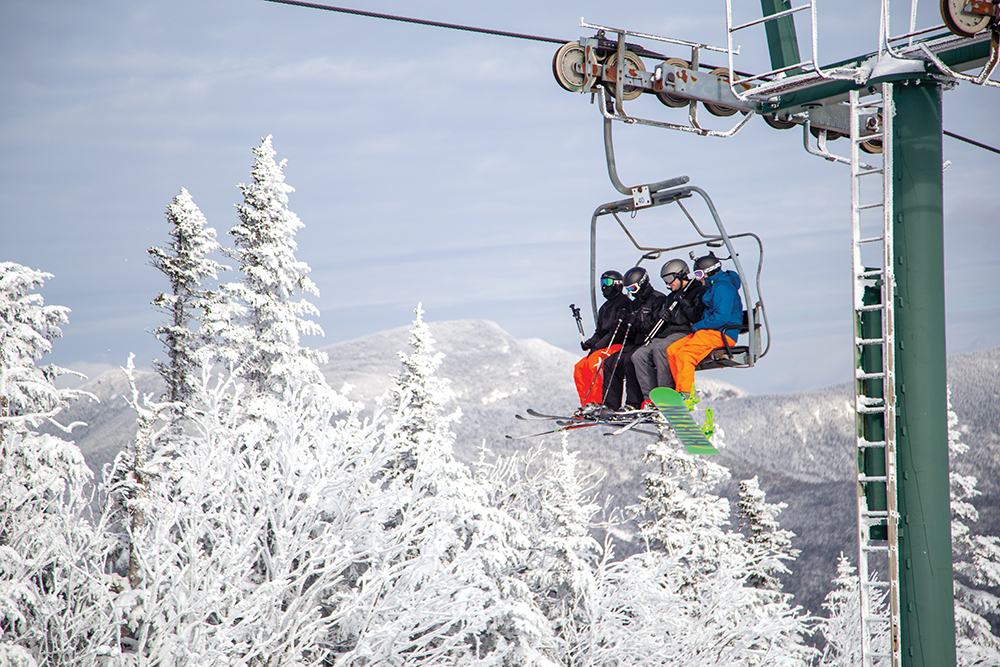
Skiers and snowboarders on the chairlift at Waterville Valley. Courtesy photo.
Waterville Valley will not be offering its valet services but instead designate a premier parking lot where people will be able to go straight to the Lower Meadows lift. “In asking our guests to treat their cars as their personal base lodge, we are planning additional ways to make all of our parking lots more accessible, including enhanced shuttle services and designing ski-to access on the perimeter of select parking lots,” says Sullivan.
Ragged Mountain in Danbury enhanced its custom app to allow guests to order food in advance or from the chairlift, says Kyle Matzke, marketing coordinator. “With all the uncertainty for the upcoming winter season, we are simply focused on keeping all of our guests and staff healthy and trying to be as accommodating as possible,” he says.
Gunstock Mountain Resort in Gilford added touchless payment technology, allowing guests to load money onto RFID season passes to spend in retail areas and restaurants, minimizing contact with others, says Kristen Lodge, marketing director.
“We have launched Gunstock Radio that will broadcast to anyone in our parking lot,” says Lodge. “The radio program will offer tips to navigate through the resort and how to use your car as your base camp since guests will boot up in their car. We will give a snow report and new tips or specials each day.”
Crowd control is also important along the often-meandering trails and tranquil meadows associated with cross country skiing and snowshoeing. Jackson Ski Touring Foundation (Jackson XC), a nonprofit in Jackson that provides cross country skiing and snowshoeing, added portable toilets at trail heads so skiers don’t congregate at one location. “We’re streamlining the rentals so people can pre-reserve. Lessons are all individual or restricted to a family or party already skiing together,” says Ellen Chandler, executive director. “We added outdoor firepits and made use of our portico.”
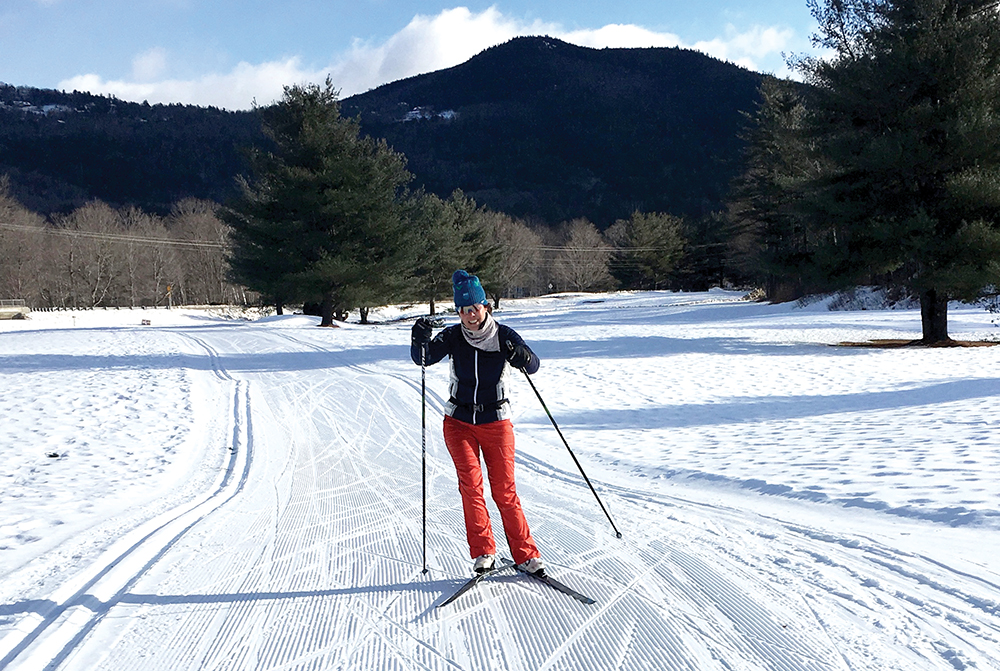
A cross country skier with the Jackson Ski Touring Foundation. Courtesy photo.
It has a 100-kilometer network of more than 50 trails. “It will require a little more patience this year but if people plan ahead and know before they go, this will be a great opportunity for people to try this sport,” she says.
The upfront investment in equipment to take up a winter sport is less of barrier once the trip to Disney or Aruba is off the table. “People looked at their nonexistent AMEX bills and thought, ‘We need to do something fun,’” says Chandler.
Other resorts are also installing a variety of outdoor bathrooms, from simple portable toilets to fancier trailer-mounted setups that offer a private stall and hand-washing sink. Placement is strategic too, intended to keep people on the trails and out of the lodge.
“With all the emphasis being on the restrictions imposed by the opening guidelines, everyone is forgetting one thing: skiers and snowboarders’ normal attire are hats, googles, face coverings and gloves,” says Tom Day, president and general manager of Gunstock Mountain Resort. “So really the experience of skiing and snowboarding on the mountain is no different than last year. How great is that?”
Snowmobilers Rev Up
It’s not just the slopes that will likely be busy. Expect heavier traffic on snowmobile trails. Typically, there are about 42,000 registered snowmobiles in NH, says Dan Gould, executive director of NH Snowmobile Association. “Registrations of snowmobiles are up, dealerships are doing brisk business, the used snowmobile market is up, and the amount of email and phone calls we are getting is off the charts,” he says.
Organized snowmobiling and the association have been in place for more than 50 years, and there is a network of clubs throughout the state. It is likely there will be more people new to the sport on the trails this year. The association is there to share rules and best practices with them.
The clubs maintain more than 7,000 miles of trails. Umbagog Snowmobile Association in Eroll is the second-largest club in NH, measured by the miles it maintains (189) and third largest in members, says club trail administrator Charlie Kurtz. It is an expensive undertaking. He says a trail groomer costs nearly $300,000 when fully equipped. Revenue generated through snowmobile registrations goes in part to Fish and Game for its law enforcement of the sport, the NH Trails Bureau for maintenance and back to the clubs in the form of grants, which cover 60% of the cost of a groomer. Clubs must fundraise to cover the balance.
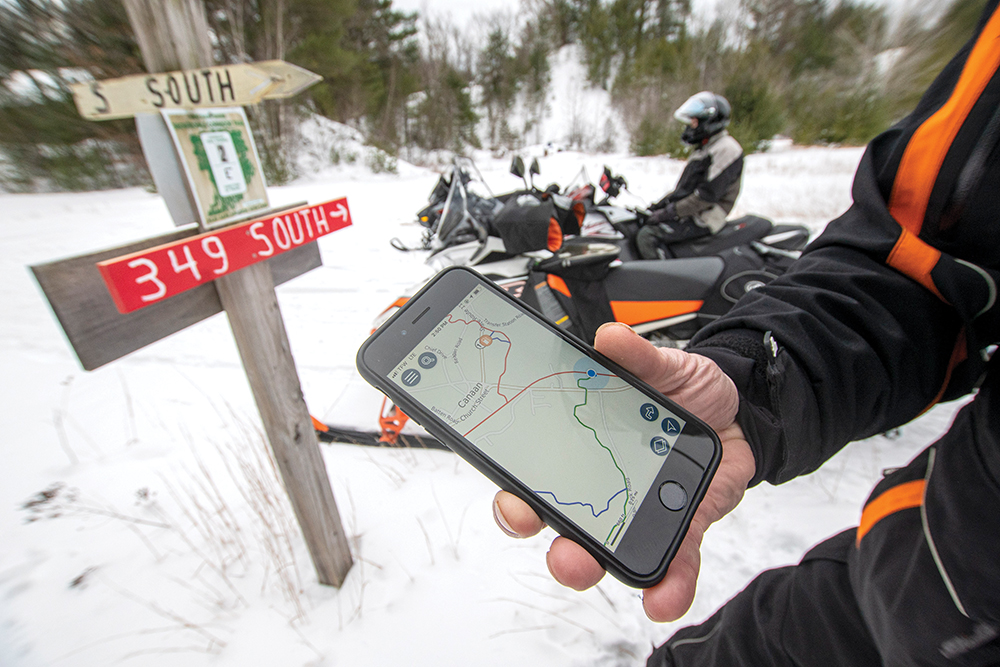
Snowmobilers using the NH Snowmobile Association trail map app, which allows them to pinpoint their location and traverse thousands of miles. Courtesy photo.
“Our membership is about 840, that’s three times the population of Errol, but snowmobilers are very generous. We do well with donations, have some great fundraisers, and our annual budget is more than $200,000 a year,” Kurtz says.
While registrations are up, many fundraisers didn’t happen this year including the biggest event for the association, the NHSA Grass Drags & Watercross, which set a record for attendance in 2019 at more than 46,500. Another big fundraiser is the NHSA ride-in for Camp Sno-Mo, an Easter Seals NH camp for kids and young adults. Gould says a committee is working hard to do a virtual event and asking clubs to find ways to raise money as well.
Clubs also have a year-round fundraising opportunity in Ride603.com, which provides branded apparel with clubs receiving 10% of revenue. Brian Labrie says he and his partners created the brand as a way to help generate some extra revenue for the 100-plus clubs in the state.
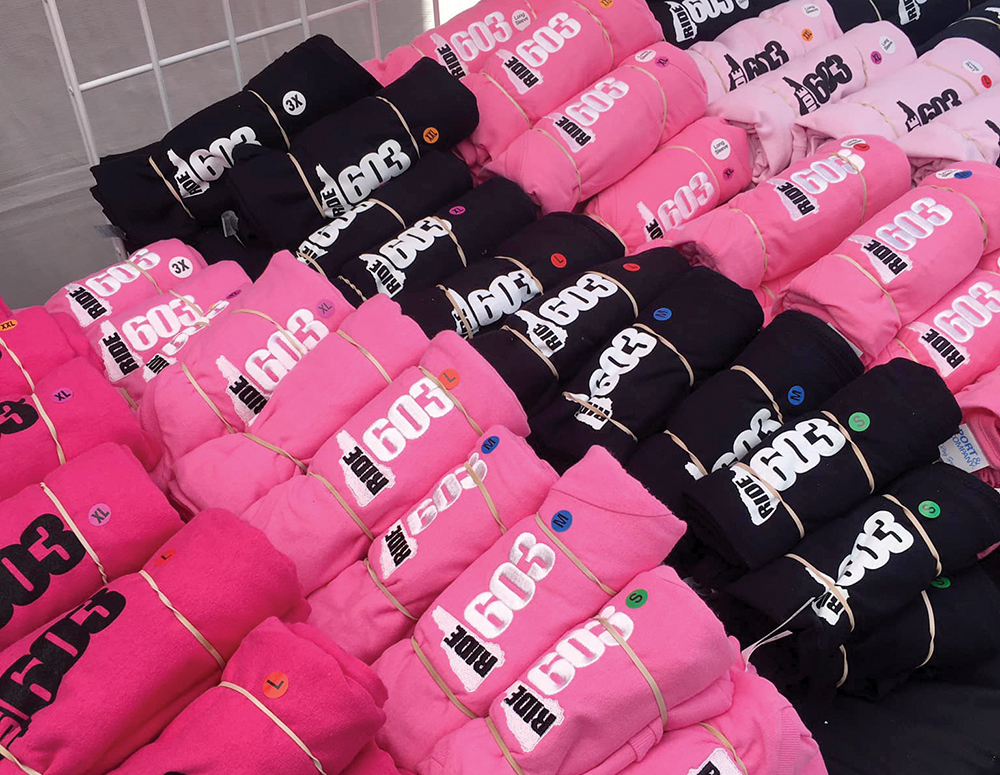
Ride603.com merchandise provides fundraising opportunities for NH snowmobile and ATV clubs. Courtesy photo.
Despite the challenges, it appears snowmobiling will continue to grow in NH, which will also benefit the economy. A 2012 economic impact study, the most recent available, estimated snowmobiling generates $586 million annually in NH, and Gould says it is likely far beyond that as every indication is 2020 could be a record year. “We are surprised at the enthusiasm,” says Gould. “Now all we need is snow.”

 Current Issue - April 2024
Current Issue - April 2024